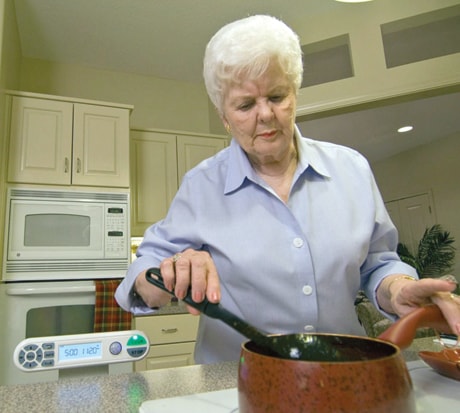At 88, Grif Crawford knows he’s at risk of a fall or other sudden health problem. So he wears a pendant around his neck that can summon help if something goes wrong.
“It’s kind of like life insurance,” said Crawford, of Lee Summit, Mo. “I feel very comforted with this.”
The device has come a long way since the days when it merely allowed the wearer to alert someone that he or she had fallen and couldn’t get up. Crawford’s equipment also can be programmed to answer his phone, remind him to take his medicine or alert him to a fire, among other things.
At-home technology can monitor senior citizens’ movements, vital statistics, sleep eating and bathroom patterns. Such devices allow older people to remain in their homes with more oversight from loved ones or medical specialists.
The products can monitor how well seniors are managing the chores of daily living, and offer “peace of mind” to caregivers or family, said Majd Alwan, director of the Center of Aging Services Technology, in Washington. The products are most successful when they are tied to an agency that can dispatch meals, medical help or other senior services, he said.
Currently, the monitoring systems, which cost about $150 to $200 a month, Alwan said. Some also are being used in assisted living facilities for additional protection.
But many people would like to see the technology become more mainstream, added Elinor Ginzler, senior vice-president for livable communities for AARP. Seniors are willing to use the technology if it’s affordable, she said.
“We’re at the beginning of the wave,” she said. “Money is an issue.”
Alwan foresees technology allowing seniors to avoid “unnecessary early institutionalization” because it will relieve anxiety for loved ones. The ability to closely monitor a person also can help family members know when the older person is unable to remain home, said Katie Boyer, director of marketing for Home for Life Solutions, in Lee Summit.
Besides monitoring falls and day-to-day activities, her company sells equipment that will turn off a stove if the user forgets.
As for managing medicine, systems exist that will dispense it at appropriate times and remind patients to take it. If the patient fails to take the medicine, the pills can move into a locked chamber to avoid an accidental overdose.
Many older people like having technology provide this extra layer of security because it doesn’t require them to give up privacy, said Agnes Berzsenyi, general manager of home health for GE Healthcare in Milwaukee.
GE has two products aimed at seniors: Health Guide allows users to check their blood pressure, sugar levels or heart rate daily. The information is sent to a medical provider who tracks it. If problems arise, the patient can have a teleconference with a nurse or schedule an appointment with their doctor.
The company also offers QuietCare, which uses sensors that learn a customer’s daily activities and behaviours, and then watch for changes, Berzsenyi explained. “It makes them feel like someone’s taking care of them but no one is watching them.”
John Cobb, CEO of Senior Lifestyle Corp., started to install QuietCare in some of his company’s 70 senior living facilities this summer because he thought it would make residents safer.
“This is not a nursing home,” Cobb said from his company’s Chicago headquarters. “We’re not watching people at night.”
Within 30 days, the system alerted staff members to five residents who had problems, he said.
“That was a very telling moment,” he said.
